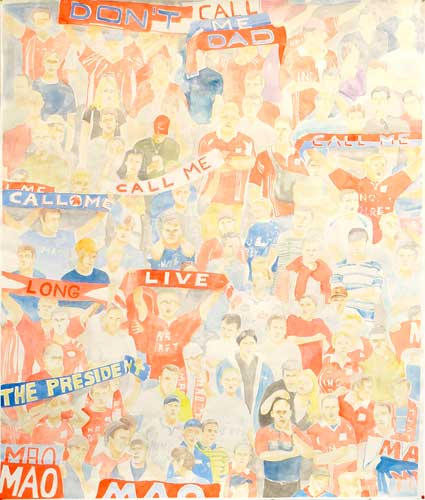Plusmarca
Art & Sport
There are several reasons that encourage us to pay attention in this new year to the relationship that exists between society, art and sport. The city of Valencia will host the World Indoor Championships in Athletics and the Formula 1 Grand Prix of Europe. In 2008 also, the Spanish daily Marca, the sports newspaper with the largest circulation and the greatest number of readers in our country, celebrates its 70th anniversary. Thanks to the coincidence of all these factors, the IVAM offers the spectator an exhibition combining the Olympic, athletic and sporting spirit, deeply rooted in the human being, and shows its links with art. Sports maintain a series of relationships with art that we can observe in the spirit of fraternity, man’s respect for man and his tireless pursuit of self-improvement. All these noble principles are required to construct sports and art. Both disciplines, art and sport, synchronise their movements to convey a message of reconciliation to the rest of the world. Let us remember that the first documentary record of the Olympic Games dates from 776 B.C. in Olympia, in Greece. From that historic time until today, their fundamental essence has always been the same, an understanding of sport as an athletic and cultural festival. “To adhere to an ideal of a higher life, to strive for perfection; to represent an elite whose origins are completely egalitarian, and whose moral qualities are outstanding; to create a truce in the world every four years, as though it were a festival of the springtime of mankind; and to glorify beauty by the involvement of the philosop hic arts in the Olympic Games.” These are a few of the solid precepts that Pierre de Coubertin defined for the Olympic Movement in the 19th century and which are fortunately still in force today and which we wish to embrace in this new exhibition presented at the IVAM to adumbrate these concepts with the also Olympic and athletic dimension of art and thus open a debate that will put the artistic and sporting spirit on the same footing. In this way this exhibition World Record. Art & Sport traces the most recent steps of sport in art. Thus, artists like Carlos Cuenllas, Avelino Salas, Juan E. Correa, Alberto Bañuelos, José Manuel Ballester, Isabel Muñoz, Juan Pérez Agirregoikoa, Josune Amunarriz, Javier Pérez, Gabriel Díaz, Tommi Grönlund & Peterri Nisunem and Keiji Kawashima submerge us in the body, nature, architecture and sport machines. The body is present in this exhibition in the large-format photographs of Isabel Muñoz, who has discovered the body as a focal point for her camera. We find nature in Reflejos de glaciar (Reflections of a Glacier, 2006), by Josune Amunarriz; the work is composed of pictorial structures reminiscent of the places where mountain climbers can simulate their climbs to the highest peaks in the world. For his part, Gabriel Díaz in El Aliento del Chomolunga (The Breath of Chomolunga, 2005) presents us with one of those colossal peaks by means of a video trip around its slopes and rugged walls, showing us the greatness of nature, renouncing, incidentally, the presence of any human figure. In this 21st century in which we live, the connection of architecture with important world sports events is crucial: José Manuel Ballester brings this home to us with his series of photographs of Olympic stadiums recently taken in Beijing. The sports machines are identified in this case with the spectacular Fórmula, 2005, by Carlos Cuenllas or the sophisticated bicycles by the Japanese artist Keiji Kawashima.



